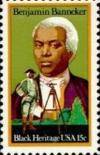¡SkyCaramba! Weekly astronomy blog for the week ending October 18, 2014
Have you ever tried to tell people something important, and they dismissed you like you’re a fool? Perhaps you felt vindicated when they found out for themselves that you were right. And perhaps that’s what Benjamin  Banneker felt in 1791. He told people about a solar eclipse that would happen on April 3 that year.
Banneker felt in 1791. He told people about a solar eclipse that would happen on April 3 that year.
Some people believed a person like Banneker (sometimes spelled Bannaker) could never learn to read. But he did learn to read as a young child just as we have come to expect all young children to learn in school today. The young Banneker was so smart, he studied the inner workings of someone else’s pocket watch and then built his own working clock from parts he made of wood. For all of his life, he studied complex subjects including mathematics, surveying, and astronomy. He also tried to persuade anyone who didn’t already know better, that skin color has nothing to do with how smart a person is.
Benjamin Banneker was born in 1731. Most black children born in Maryland then were slaves. Some were given freedom later in life or were allowed to earn and save enough money to buy their freedom. Banneker’s parents were already free, so under Maryland law he was free too. He used his freedom to build an outstanding reputation as an intelligent man and call for an end to slavery.
He shouldn’t have needed a credibility boost, but he got one during the annular eclipse of 1791. Banneker told people that on the morning of April 3, the moon would pass in front of the sun. His hometown area in Maryland  would get a good view of a bright ring in the sky! There must have been a lot of people who didn’t believe him, because he became well known for predicting an eclipse that no one else saw coming.
would get a good view of a bright ring in the sky! There must have been a lot of people who didn’t believe him, because he became well known for predicting an eclipse that no one else saw coming.
Later that year, a surveyor staking out the new District of Columbia hired Banneker to help take astronomical measurements and make calculations. And for six years after that, Banneker published Benjamin Banneker’s Almanac. He included in the almanac the usual information found in such publications in those days about sunrise and sunset times, the moon’s phases, where to find the planets, the tides, and—of course—eclipses.
There are many exaggerations about Banneker’s abilities and accomplishments. One legend claims he predicted the April 3, 1791 eclipse and no one else did, even though the event was listed in almanacs for that year published before the year began. Another legend says Banneker reproduced from memory the entire layout for the District of Columbia after the lead designer quit in a huff and took the plans with him. The truth is, Banneker had taken ill and left the survey team already.
Debunking the myths should in no way diminish one’s respect for Benjamin Banneker. This author would rather hold the man in high esteem for the things he actually did, because Banneker’s unembellished record is pretty impressive itself. The real story of how things were and how one man refused to be defined by others’ low expectations should be an inspiration for anyone.
¡SkyCaramba!
http://www.pbs.org/wgbh/aia/part2/2h68.html
http://www.biography.com/people/benjamin-banneker-9198038#early-years
http://eclipse.gsfc.nasa.gov/SEsearch/SEsearchmap.php?Ecl=17910403